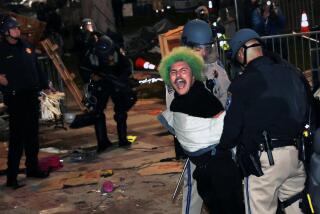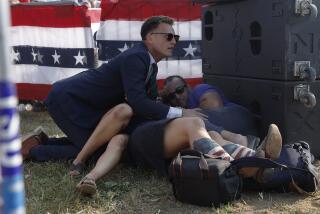Police are all ears when it comes to sound cannons
- Share via
Sound has long been used as a weapon. The Germans put sirens on Stuka dive bombers in World War II to amplify the terror to unlucky souls below. Jamaican maroons — fugitive slaves — used the abeng horn to unnerve British colonial soldiers.
The U.S. Army blasted rock music to torment former Panamanian dictator Manuel Noriega. And according to the Bible, Joshua brought down the walls of Jericho by having his priests blow rams’ horns.
Now, the power of loud noise is being harnessed by police departments.
A device known as the sound cannon is joining Tasers, rubber bullets and pepper spray in law enforcement’s expanding arsenal of nonlethal weapons.
It’s officially called the Long Range Acoustical Device, or LRAD, and it has two primary uses. One is as a high-tech megaphone that generates a beam of sound that can cut through the din of a noisy protest far better than conventional public-address systems.
It also functions as a tactical weapon — projecting a high-pitch chirping sound that makes people cover their ears and run away. And with a maximum volume of 149 decibels, the LRAD can get about as loud as a jetliner on takeoff.
Pittsburgh police used LRADs mounted on an armored vehicle to break up demonstrations jamming the city’s downtown during the G20 international economic conference in 2009. More recently, New York police officers used small, hand-held LRADs to bark orders as they ousted the Occupy Wall Street protest from Zuccotti Park.
The Los Angeles Police Department has an undisclosed number of LRADs, but they are larger devices fixed to vehicles, which they say might have been helpful in breaking up the Occupy Los Angeles encampment at City Hall this week. Police did not have hand-held units.
LAPD Cmdr. Bob Green said orders to disperse made with bullhorns went largely unheard because of the din of crowd chants and helicopters hovering overhead. The police had to use pickup trucks with massive speakers to get the orders across.
“It’s frustrating when you’re not heard in those situations because ultimately it’s all about communications,” Green said. “Bad things happen when the batons are out and the adrenaline is flowing. So, if there’s something better out there to get the message across, let’s have it.”
The device was developed for the Pentagon by San Diego military contractor LRAD Corp. after the Sept. 11 terror attacks as a sonic weapon to help control unruly crowds, foil hijackers and keep other potential threats at bay.
The Pentagon and law enforcement agencies are among the biggest customers, but there are civilian uses as well.
LRAD sells sound cannons to yacht owners as a means of keeping pirates from boarding. In 2005, an LRAD sound cannon staved off an attack by pirates on a five-star German-built cruise ship, called Seabourn Spirit, off the coast of Somalia.
The company also markets versions of the device for wind farms and aircraft owners, to scare off birds. There are six models, from one resembling a small stereo speaker to another as large as a home satellite dish. They are priced from $5,000 to $100,000.
There are a few competitors in the acoustic device market, among them HPV Technologies Inc. of Irvine and Ultra Electronics USSI of Columbia City, Ind.
“Interest in our technology has never been stronger,” said Scott Stuckey, vice president for business development at LRAD. “It offers a safe solution for potentially dangerous situations.”
Unlike a traditional loudspeaker, the device directs a loud beam of sound across a room like a spotlight — hence the name, sound cannon.
Although it may be nonlethal, critics say that it could damage hearing or cause psychological harm.
Joshua Paul, a student at Rutgers University who was at the Occupy Wall Street rally, described the sound from the LRAD as “high-pitched and very disabling.”
Afterward, he wrote on Twitter: “High pitched noise. Natural reaction: My face scrunched and hands started moving to my ears. Length was around 5 seconds.”
Although the New York Police Department denies ever using the LRAD for anything other than a loud speaker, the device is capable of incapacitating people. That was the sales pitch to the Pentagon when San Diego inventor Elwood G. Norris developed the LRAD idea.
Norris said the need for the technology was demonstrated by the 2000 suicide attack on the Navy warship USS Cole that killed 17 American sailors in Yemen. The Cole’s crew could not use lethal force against the interlopers because it did not know their intent, but a nonlethal sound cannon could have been deployed.
“If they had the LRAD to keep the terrorists at bay,” Stuckey said, “who knows what would have happened?”
What makes the device different from previous sound technology is that the person standing behind or next to the device does not hear the sound as loudly. Conventional speaker systems generate sound that spreads out. On an LRAD, the sound is condensed into a single beam.
“You can direct the beam wherever you want,” Stuckey said. “It hits the sweet spot of human hearing. It’s similar to having a really bright light in your eyes.”
Its debilitating effect can be seen in a YouTube video of a crowd of protesters at the G20 summit in Pittsburgh in 2009. Police rolled through the street in an armored truck with an LRAD device fixed atop like a turret generating a loud sound beam into the crowd.
In an instant, the high-pitched chirping appears to compel nearly every person in the crowd to cover their ears.
In the crowd was Karen Piper, an English professor at the University of Missouri, who says she suffered immediate pain in her ears and became nauseous and dizzy. Piper said she was unable to cover her ears because she was holding bags, her purse and a camera.
“All of a sudden I heard this excruciating high-pitched noise. It was debilitating,” she said this week. “I never heard anything like it before.”
In a federal lawsuit filed in September against the Pittsburgh Police Department by the American Civil Liberties Union on her behalf, it states that she suffered permanent hearing loss.
LRAD declined to comment on the lawsuit.
Times staff writer Joel Rubin contributed to this report.
More to Read
Inside the business of entertainment
The Wide Shot brings you news, analysis and insights on everything from streaming wars to production — and what it all means for the future.
You may occasionally receive promotional content from the Los Angeles Times.







